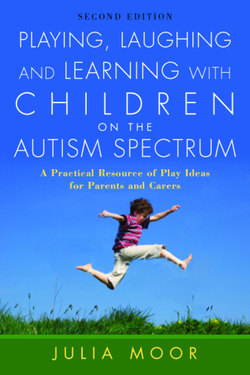Читать книгу Playing, Laughing and Learning with Children on the Autism Spectrum - Julia Moor - Страница 19
На сайте Литреса книга снята с продажи.
Creating play opportunity – setting the stage
ОглавлениеEach of the following chapters in turn draws your attention to sensory problems that may hinder playing with that particular activity and the importance of checking the play environment, so I won’t repeat this again here.
Remember to be responsive to your child’s level of tolerance to direct requests – if he is resistant, pull back; introduce the activity that you have planned into the day ‘indirectly’. Play alongside your child as if for your own pleasure, set up a duplicate activity within his reach and keep the session very short (one or two minutes at a time). If you feel that introducing structured play and learning is ‘beyond’ your child at the moment, concentrate on the less invasive forms of interaction, such as the activities described in Chapters 7 and 9, as well as the ideas on ‘sharing space’ detailed in Chapter 2.
When you begin systematically to ‘teach’ a child with autism to play, it helps if you have worked out a few things beforehand:
Know exactly which objects you will be using – ‘exactly’ means just that, have ready only the toys/materials that you will need for that particular activity. Decide whether things such as the box they come in will be distracting and, if so, remove them.
Know what the play area will be – the living room floor/a table/a tray top/a rug. Does your child need a prop to remind him that this is where his focus of attention will be, a special cushion to sit on, or a picture card reminding him to stay seated?
If you are using picture prompts (the importance of visual supports is explained at the end of the chapter), check they are not confusing or ambiguous or that your child is not interpreting them too literally. See Chapter 4 for lots of ideas on making the most of your computer to access and make visual supports.
Are you going to use a reward or reinforcer for your child after he has completed an activity – something tangible to motivate him to attempt it? Do you have a card to communicate this to your child? For further details on reinforcers see Chapter 5.
How long do you expect your child to engage in the activity? How simple or complicated are your goals? What actions and/or interactions do you specifically want your child to achieve? This may be something as simple as turn-taking with stacking rings or as complicated as an imaginary play sequence with a set of figures.
When you have answered these questions and have the materials and objects to hand, you have set the stage.
